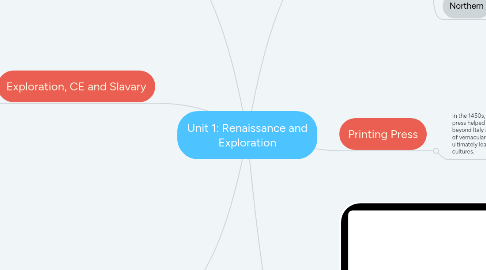
1. Renaissance
1.1. Italian
1.1.1. In classical literature, Italian Renaissance humanists, including Petrarch, encouraged a revival and produced new philological approaches to ancient texts. Some humanists in the Renaissance embraced the ideals of secularism and individualism.
1.1.2. Brought a new way of thinking, and encouraged art, and other professions.
1.1.2.1. Michaelangleo and Raphael brought a new style of art, and popularized naturalism
1.1.2.2. Empiriscism stated to grow
1.1.2.3. Rational causes where sided more than the church
1.1.3. New thinking led to the idea of restricting the financial system, such as fiscal policy and welfare state
1.2. Northern
1.2.1. The Northern Renaissance retained a more religious focus, resulting in more human-centered naturalism, which considered suitable subjects of artistic expression to individuals and to everyday life.
1.2.1.1. advent of mechanically reproducible media such as woodcuts and engravings
1.2.1.2. Protestant Reformation and the translation of the Bible from the original languages into the vernacular or common languages such as German and French
1.2.1.3. formation of a merchant class of art patrons that purchased works in oil on panel
1.2.1.4. Embodied in Erasmus' writings, Christian humanism employed Renaissance learning in the pursuit of religious reform.
2. Printing Press
2.1. In the 1450s, the invention of the printing press helped spread the Renaissance beyond Italy and facilitated the production of vernacular literature, which would ultimately lead to the growth of national cultures.
2.1.1. Bibles were being produced at a very fast rate
2.1.2. The invention of the printing press actually spread the idea of Christianity even further around Europe, and soon to other countries around the world
2.1.3. The availability of the books encouraged people to read or learn how to read more
2.1.4. the printing press, more than anything, fueled the spread of Renaissance ideas
3. New Monarchs
3.1. Monarchs and princes, including the English rulers Henry VIII and Elizabeth I, initiated religious reform from the top down in an effort to exercise greater control over religious life and morality.
3.1.1. New monarchies laid the groundwork for the authoritarian modern state by creating tax collection monopolies, using military power, dispensing justice and obtaining the right to decide their subjects' faith.
3.1.2. Commercial and technical organisations have gained influence in Europe and have played a greater role in political affairs.
3.1.3. In Renaissance Italy, continued political fragmentation provided a backdrop for new conceptions of the secular state to be created.
4. Exploration, CE and Slavary
4.1. Exploration
4.1.1. To increase personal wealth and state power, European states sought direct access to gold, spices, and luxury goods.
4.1.1.1. The emergence of mercantilism gave a new role to the state in fostering economic growth and gaining overseas colonies.
4.1.1.2. As governments and religious leaders tried to spread the religion, Christianity was a catalyst for discovery, and it acted as a pretext for the subjugation of indigenous civilizations for others.
4.2. Colonial Expansion
4.2.1. The colonial expansion of Europe led to a global exchange of commodities, flora and fauna; a transition to European domination; and the expansion of slave trade.
4.3. Slavery
4.3.1. In response to the development of a plantation economy in the Americas and demographic catastrophes among indigenous peoples, Europeans extended the African slave trade.
5. Commercial Revolution
5.1. Banking and finance advances have fostered the development of urban financial centres and the monetary economy.
5.1.1. The Commercial Revolution helped to connect Europe with the rest of the world through trade, commerce, and investing. It brought the European influence to other countries, and in turn these countries influenced Europe when it came to food, clothing, and other items.
5.1.2. Economic shifts that happened during the Industrial Revolution include inflation due to the influx of gold and silver in Europe, the stock exchange, and what we now know as the modern banking system.
5.1.3. The trade in commodities, which was made possible by European exploration of other nations, was an important part of the Industrial Revolution.
5.1.4. The Commercial Revolution led to capitalism. During this important phase in European history, goods and currency were rapidly exchanged, and the fact that goods were available in much larger quantities than in the past allowed for competitive pricing. The nobles began to lose power, and the class system was no longer as fixed.
